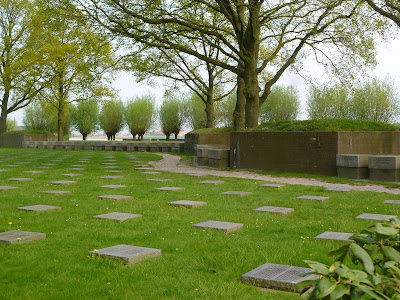"In Flanders Fields" is a poem from the first world war, the 'war to end all wars'...if only that was so. Written by Lieutenant Colonel John McCrae, a Canadian physician, it is a powerful and enduring description of the battlefields of Belgium. Flanders is in the north of Belgium and saw some of the worst fighting and trench warfare in the history of war. Tracy and I visited on our trip to Belgium and the Netherlands.
WWI began 99 years ago on the 28th of July, 1914; and ended over 4 years later on the 11th of November, 1918 (at 11:11 of the 11th day of the 11th month). There were 2 major European fronts to the war, just like in WWII, but the eastern front became less of an issue after the Russian revolution and an armistice between Russia and Germany. The primary combatants on the western front were the British Commonwealth and Germany, of course. The French were also heavily involved, but the actual Belgians were mostly in occupied territory and their army had effectively surrendered with only some guerrilla resistance. There were more than 2 fronts really, as battles took place in the Balkans, Italy, and even the far east. The Ottoman Empire fell as a result of the war and terrible battles took place in the Dardanelles at Gallipoli (the Dardanelles is the straight of water connecting the Aegean Sea and the Sea of Marmara in northwest Turkey. The United States entered the war very late, on the 6th of April, 1917, though it took troops a couple months to arrive. They were something of the 'nail in the coffin' for Germany though. We saw many, many graves but none of them happened to be American. Most graves were British Commonwealth, which included Canada, Australia, New Zealand and India, among others.
 |
| Dog tags weren't in use yet, so many bodies couldn't be identified. |
 |
| Tyne Cot, the largest Commonwealth Cemetery in the world. |
Though they weren't yet in bloom, the poppy flower is the symbol for remembrance of WWI. You still see plastic versions all over London, on the grills of taxi cabs mostly. Poppies grow wild all over Flanders and would still bloom even during the war, despite much of the ground being a bomb-riddled mud pit. They say that along the front, 3 shells landed for every square meter.
 |
| Poppy wreaths (made of plastic so they last) |
 |
| Names of soldiers whose bodies were never found. |
After the war there were few buildings with even a portion of a wall still standing. Trees, if they still stood, were nothing more than shredded trunks. The ground was mud, quicksand essentially that could swallow a man or trap him until he died. With the massive explosions of underground mines (one series of blasts could be heard in southern England), the muddy earth swallowed up bodies and body parts. Some of these are still being found today too, though rarely now.
Farmers constantly find unexploded shells in their fields. They lay them
out by the road and bomb disposal units collect them (eventually, it
may take many days) and dispose of them. Despite this process going on
for years; they have many, many more years of work to do. The shells
containing poison gas take more work and require more care.
 |
| Shells found in a field |
 |
| Rifles |
The German dead were buried here as well, though the Belgians are less inclined to take care of their cemeteries. Many of the German graves have been moved and often ended up in mass graves. Their cemeteries had a more somber look.
Poison gas was used extensively throughout the war. At first it was more effective, but troops quickly learned to adapt and protect themselves. Casualty rates dropped but gas continued to be used and feared. Despite our perceptions, the Allies used it more often the the Axis powers.
 |
| Canadian Monument commemorating the first German gas attacks. |
 |
| Pointing to Ypres, the town at the center of the Flanders Fields battlefield. |
Ypres is a cute little walled medieval town town that had to be completely rebuilt because little more than the devastated ruins of the church remained after the war. The British held the town which was shelled relentlessly. Major battles took place in the attempt to take the town and the nearby Passchendaele Ridge.
 |
| ...more to come. |








































